REPORT FROM THE “BLACKBURN TIMES” OF FEBRUARY 25th 1871
On Saturday last, a new school, the gift of the Dugdale family of Griffin Lodge, Witton, built in the centre of the Griffin estate was opened. It is built by Mr. Richard Hacking from the design of Mr. James Birtwistle, Architect. No reasonable expense has been spared, and the entire cost has been defrayed by the Dugdale family.
The opening was celebrated by a public tea party, at which about 600 people were present. After tea a meeting was held, and on or near the platform there were Mrs. Rodgett, Miss Dugdale, Mrs. Carr, Mrs. Woodhouse, Thomas Dugdale, Esq, Adam Dugdale, Esq, Alderman Lewis, H. Harrison, Esq, Isaac Ward, Esq, the Rev. G.H Ashe, Rev. C.W Woodhouse, Rev. A. Gallagher, Rev. W.T Vale, Rev. W. King, Rev. G. Parker, Rev. G. Burwell, Rev. R.J Langford and Rev. J. Noble. The Rev. G.H Ashe was called to the Chair by acclamation.
He said:
Ladies and Gentlemen – It affords me unmixed pleasure to meet my Christian friends in this crowded building tonight. I beg to congratulate my friend, Mr. Dugdale, on this noble building. When it was begun I wished him God speed. No one has given Mr. Dugdale any assistance or support: The whole honour is due to Mr. Dugdale and his family. (Loud cheers).
I must say that I never saw any work carried out more unostentatiously or more efficiently according to the scriptural injunction “whatever thy hand findeth to do, do it with thy might”. The result is this noble, this magnificent building, and I earnestly pray that God’s blessing may rest upon it; that the young men who may be educated here may be good men; that the girls, through the inoculation of sound Gospel truths may become good women; that all the young persons taught in this school may become good Christians, and that Mr. Dugdale may long live to see the good effects of his benevolence. (Loud cheers).
The Rev. C.W Woodhouse moved the following resolution –
“That the best thanks of this meeting, and the inhabitants of the Griffin Estate, and especially the members of the Church of England, are due to Thomas Dugdale, Esq., J.P., Mrs. Rodgett, and other members of the Dugdale family, for their munificence in erecting this spacious and handsome building, and freely dedicating the same to Church and School purposes”. (Applause).
Henry Harrison, Esq., seconded the resolution which was then put and carried amidst rounds of applause.
Thomas Dugdale, Esq., on rising to respond, was received with a hearty outburst of cheers. He said:-
“Ladies and Gentleman – I have, in the first place, to thank you for the address that has been given by your Vicar, because it will very much shorten my speech. The Vicar has said what I intended or ought to have said. (Applause) I will simply state that it is rather more than 34 years since I purchased the Griffin Estate. I have lived upon it upwards of 13 years. During that period both myself and members of my family have received due respect from the majority of the inhabitants of Witton. (Applause) With respect to the education of this district, I can state at once that long before the Education Act was talked about, myself and family had determined to build a school. (Hear, Hear and Applause) I can assure you that 34 years ago there were only ten houses upon the Griffin Estate, and for a long time the number of inhabitants in the township of Witton was almost stationary, but during the last 20 years the population has increased to such an extent that the Church and School at Witton did not possess the requisite accommodation.
I have great pleasure in aiding your worthy Vicar in supplying the wants of this vastly increasing district, by dedicating on this occasion the building in which we stand to be used as a Sunday School and Day School for the education of children of all denominations. (Applause).
I can assure this assembly that it is the wish of myself and family that the children educated herein may be brought up in the nurture and admonition of the Lord – that they may learn as much religion as will fit them for a future blessedness – that they may learn to revere the Sabbath and keep it holy – that they may be subject to and obedient to their parents – that on all occasions they may be sober, honest and respectable members of society, and afterwards become good husbands and good wives, and an honour to the district in which they live. (Applause).
I cannot do more than return best thanks for the resolution which has been passed, and I hope that the morality of Witton and district may be improved hereby”. (Loud Cheers).
A concert followed and the meeting was brought to a close by the singing of the National Anthem.
THE SUNDAY SCHOOL
The Sunday School commenced on 19th February, 1871 and its first Superintendent was Mr. Henry Hargreaves (clerk at Griffin Mill). Mr. Hargreaves was succeeded by Mr. J. Kenyon, Mr. Pinder, Mr. P. Thompson, Mr. B. Aspinall, Mr. W. Newton and Mr. T. Hodgkinson.
The Sunday School possesses two large banners. Both of these were bought from Messrs. Brown of Manchester and both are hand embroidered. The older of the two, portrays St. Philip, and was bought about 1887, and cost about £50. This amount was subscribed in the Parish. The reverse side of this banner portrays Christ blessing little children. The newer banner was bought in 1909 and also cost £50, again subscribed in the Parish. One side of this portrays the Good Shepherd and the reverse side St. Philip’s Church.
The two banners mentioned above replace the two original banners, which were painted on silk by W.H Cunliffe, decorator, Blackburn. The first of the original banners was bought in July 1871, and had a painting of the school on one side. The second was bought in about 1881 and had St. Philip’s Church painted on one side.
For many years Mr. & Mrs. A Dugdale and Mrs. R.B. Rodgett gave Christmas books to the children of the Sunday School, and Miss E.M.D Dugdale gave a yearly tea. Miss. E. Dugdale paid the School Subscriptions to the Sunday School Association annually, whilst Miss. B. Dugdale provided all new Banner Ribbons and also the yearly Picture Cards and albums for the Infants.
GRIFFIN C. of E. SCHOOL
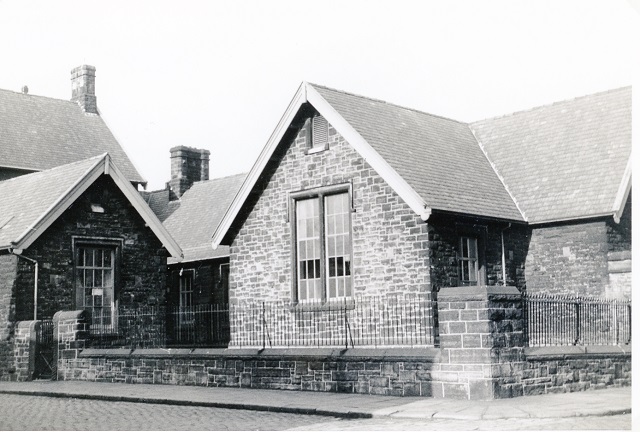
Griffin School
A century ago in 1870 School boards were established and empowered to draw up byelaws regarding compulsory attendance of children at school, but long before the Education Act was talked about, Mr. Thomas Dugdale, Senior, of Griffin Lodge, had decided to build a Day and Sunday School for the “Half-Time” children employed at Griffin Mills.
The School was built by Mr. Richard Hacking from the design of Mr. James Birtwistle, Architect, and the entire cost was met by the Dugdale family. The original building consisted of a Boys’ Schoolroom; Girls’ Schoolroom, two small Girls’ class rooms (one above the other); a store room; two sets of offices and two playgrounds. The cost of the original building was £11, 302, of which Mrs. R. B Rodgett gave £1,000 and the rest was defrayed by Mr. Thomas Dugdale (Senior).
The Sunday School was opened on the 19th February 1871, the first Superintendent being Mr. Henry Hargreaves, clerk at Griffin Mill. The Day School commenced on Monday 27th February 1871, having Boys’ and Girls’ departments, the Infants being under the care of the Girls’ Head Mistress. The first Head Master was Mr. Loynd, and the first Head Mistress, Miss Lund.
The School was also used for Divine Service on Sundays, Morning and Evening and was licensed for Baptisms and Holy Communion, this continued until St. Philip’s Church was consecrated. The Revd. G. A. H Ashe arranged for one of his Curates, (whose stipend was defrayed chiefly by the Dugdale family) to take charge of the Griffin District. The Curates were successively, Rev. W. Perfect Bell, Rev. James Place and the Rev. John. O. Pinck.
In 1873 the Infant School room was built by Mr. T. Dugdale (Senior) at the cost of £560-10- 0d. Mr. T. Dugdale Snr. Died on 17th March 1875, and the school became the property of his son, Mr. Adam Dugdale. In 1877, Mr. Adam Dugdale built three class rooms and a store room, for the Boys’ Department, that is, two small classrooms downstairs and a large classroom above, with storage adjoining. The cost was £532-16-3d. A few years later by advice of H.M. Inspector of Schools the middle wall separating the two downstairs classrooms was taken away, leaving one classroom the same size as the upper room.
In 1879 the Infants’ School became a separate School under the Head Mistress, Mrs. Elizabeth Ann Woodcock, who took up her duties on 6th January 1879. During this same year Mr. Adam Dugdale built a class room, half way up the Girls’ staircase, it was built as a thank offering for the birth of Mr. A. Norman Dugdale and the cost altogether amounted to £269-1-10d. It was used for many years for Mothers’ Class Meetings.
In 1888 Mr. Adam Dugdale built the classroom which communicates with the Infant School Room at a further cost of £182-3-4d. In 1899 Mr. Adam Dugdale built the top Class Room over the Infants’ School to be used on week days by the older girls. This involved a total alteration of the Infant School roof, alterations and lengthening of a staircase and abolishing of a store room. The new room became known as the Diamond Jubilee Class Room. The cost was £990. At the same time the two Girls’ Class Rooms were enlarged, both were made about twice their original length. During these alterations some of the pupils were taught in the Wesleyan School, the rooms were rented for several months.
In 1900 the Girls’ Cloakroom was built by Mrs. Adam Dugdale. The cost was £152-17-4d. Previously girls and infants had only two fixed wash hand basins in the girls’ passage. Also in 1900 the Boys’ and Girls’ School rooms were re-floored with wooden blocks by Mr. Roger Lowe of Bolton who had previously done the flooring of the Infants’ Class room. It is recorded that men from Griffin Mill worked for about three weeks, moving soil etc. when these floors were fitted.
The Education Act of 1902 placed Griffin Day School under the Blackburn Education Authority. The appointed day when the Act began to take effect in Blackburn, was 1st April 1903. In order to safeguard Griffin School as a Church of England School, under the new conditions, Mr. Adam Dugdale put the School in Union with the National Society. The Memorandum of Agreement was executed on 6th March 1903 and provided that the Vicar for the time being of St. Philip’s Church, Griffin, shall be ex-officio, Chairman of the Managers, and that the other Foundation Managers must be bona fide members of the Church of England.
Electric light to replace gas, throughout the school was installed in 1913 by Mr. Adam Dugdale. On 20th January, 1917 Mr. Adam Dugdale died and the school became the property of his son Mr. A. Norman Dugdale.
Although the numbers attending the Day School steadily increased until about 1888, (at one time there were about 800 scholars on the Registers on the last day of the school year) they then steadily declined. A careful investigation proved that this was chiefly due to a declining birth rate and to a decrease in the number of Church of England families living in the vicinity of Griffin School. By 1921 the consequences of the war and setting up of Central Schools were further causes of this decline.
In 1926 the Head Teacher of the Girls’ Day School resigned, and after consultation with the Local Education Authority and with H.M.I. Mr. Richardson, the Managers decided to work the Boys’ and Girls’ Schools as a mixed school under the Headship of Mr. Gorse. The reasons for this were the decrease in the number of scholars on roll owing to decrease in birth rate, and the need for economy in working owing to depression in trade etc.
This change took place at the beginning of the School year, 1st April 1926. At the same time the Board of Education put the School under the new accommodation rules, there being a decrease in the number of scholars allowed. The Board also asked for certain alterations to the school premises, which were all carried out and other improvements also made.
On 23rd April 1929, Mr. Gorse resigned the Headship of the Mixed Day School and the Managers appointed Mr. P. Thompson to succeed him from 1st July 1929. Mr. Thompson died in February 1932 and on 1st June 1932 Mr. Albert Dixon, who was at that time Head Teacher of Cherry Tree National School succeeded Mr. Thompson. In September 1946 Mr. J. S. Wilkinson was appointed as Headmaster and served in that capacity until the end of the summer term 1970. Mr. Wilkinson left Griffin to become Headmaster of St. John’s C.E Junior School and Mr. Henry Baldwin now holds the position of Acting Head Teacher in the Junior School.
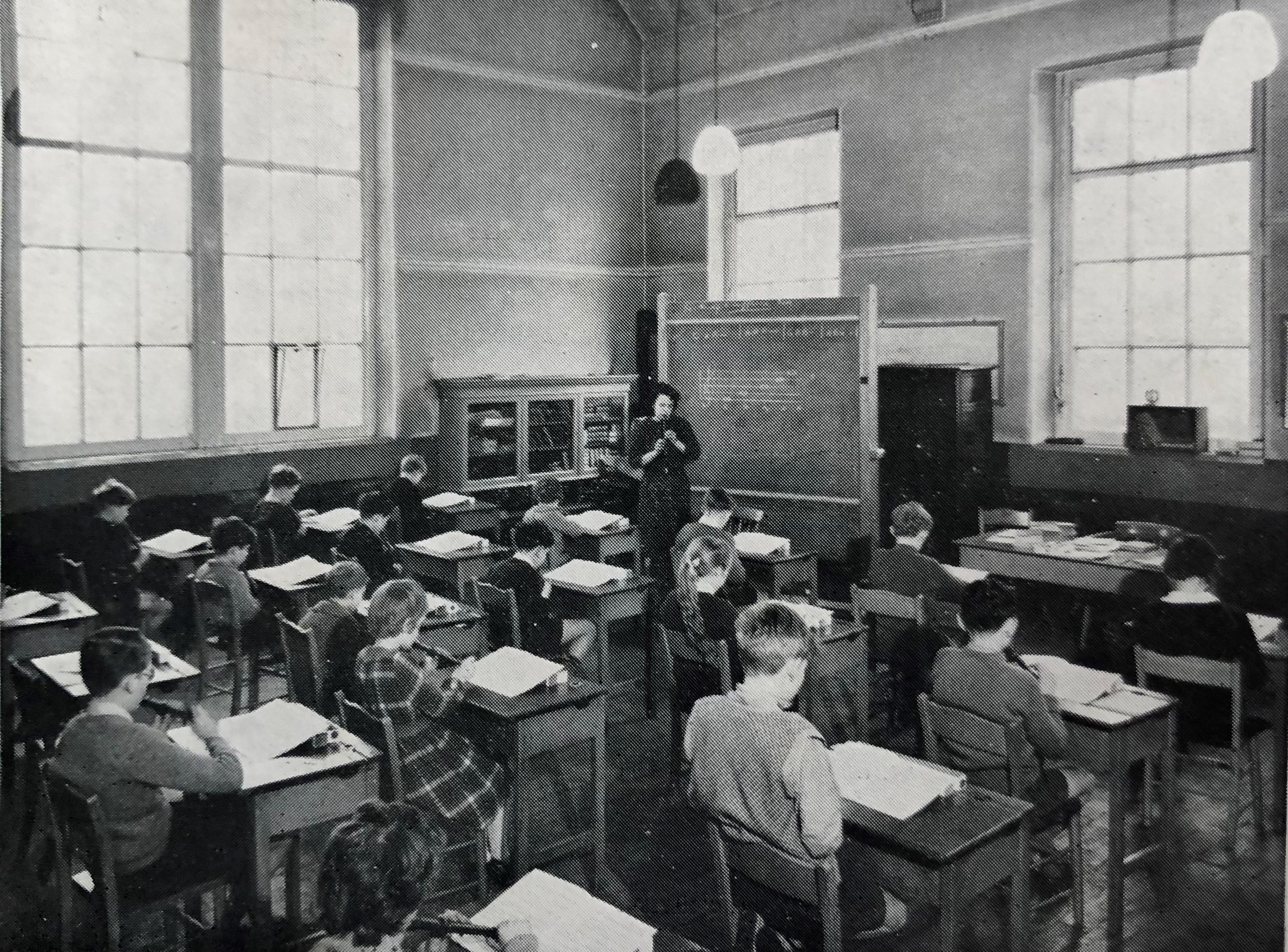
Classroom at Griffin School
GRIFFIN C. of E INFANTS’ SCHOOL
On the 6th January 1879 The Infants’ School at Griffin became a separate school under the Headship of Miss Elizabeth Ann Woodcock. It is recorded that at that time there were 91 children present and that Miss Woodcock found the children very troublesome. It would appear that Miss Woodcock was in sole charge of the ninety one children, the only other assistant being a monitor. A list of articles were ordered for school use which consisted of two dozen slates, 2 boxes of pencils, one box of chalk, a set of pointers and two alphabet sheets. It is interesting to compare Miss Woodcock’s requisition with a typical requisition list of today.
From time to time the Head teacher had great difficulty in obtaining the “School Pence” from the children and it is recorded that this was often because of strikes in the mills, or through poverty. In March 1881 the fees were raised for children in Standard I from 2d. to 3d. per week. By September of 1891 school fees for children in the Infants’ School were abolished.
During the late 19th century and the early 20th century old records show that many children who attended this school died from measles, scarlet fever, typhoid and croup. The school was closed on several occasions because of low attendance and epidemics of the above mentioned diseases prevailing in this area.
In October 1879 there appears in the Log Book an entry which states that the children were given a holiday owing to a Sale of Work (on behalf of the new church) being held in the School. The new church being the Parish Church of St. Philip. Another entry for the 17th December 1880 states that the children were allowed out of school early in order that the room might be prepared for the consecration tea party which took place on Saturday 18th December 1880.
By January 1882 the number of children on roll of the Infants’ School was approximately 200.
In 1884 Miss Woodcock retired to be succeeded by Miss Sarah Pickering who was the Mistress in the Infant School for 37 years. Miss Pickering introduced Drill into the time table and dumb-bells were provided as school equipment. It is noted that the children enjoyed their drill and it was soon performed to music.
Many important people have passed through the school doors, including Bishops, Lords, Ladies, Lieutenants and Clergy etc., and the school children have benefited on many occasions from the generosity of Mrs. Dugdale and the Dugdale family.
The School has received many gifts, and successive Head Teachers have noted these and expressed their thanks in the School Log Book. It is recorded that a stuffed ostrich was received for school purposes, whether the mistress considered herself fortunate or not in this case she does not record. It would appear that with 230 children on the roll at that particular time she would be pleased to find that it was a dead specimen, whether she had room to display it to its best advantage is very doubtful.
In 1921, Miss Gibbons succeeded Miss S. Pickering and served for 15 years as Head Teacher. During the Headship of Miss Gibbons it was agreed that the accommodation of the Infants’ School was fixed at 185. In 1926 major improvements and additions were made to the building. The total expenditure is recorded as being £412-13-5d. after deducting 5s received for the sale of an old meter.
When Miss Gibbons terminated her duties on the 15th July, 1936, Miss Emma Walsh became temporary Head Teacher until the appointment of Miss Eastwood on 1st March 1939.
Miss Eastwood, later Mrs. Pearce, served the school as Head during the last war and several references appear in the log Book regarding events of the war years. It is noted that the children brought their gas masks to school, that gifts were sent to Calderstones Hospital for wounded soldiers, contributions were sent to the Spitfire Fund, War Weapons Week, Wings for Victory Week, Merchant Navy Week, War Ships Week, Add to China Week, that the children collected salvage, and that school hours were altered because of the “Blackout”.
On August 17th 1942 School dinners were served to the children for the first time, and on August 26th 1946 milk in schools became free.
Mrs Pearce terminated her duties on 31st December 1955 after 17 years service in this school, then Miss Wood who later became Mrs West commenced duties on 1st January 1956.
As Mrs. West left in December 1968, to take up her present appointment at The Cedars, the new Bank Top- Griffin School was already planned, and the site in Griffin Park had been chosen, it was therefore, decided to appoint a Temporary Acting Head, and Mrs. Vause took up this appointment on 1st January, 1969.
The school at present consists of only 50 children with 2 classes and vertical grouping, modern methods are in use so that the children will be ready to move into a new building.
As we look back on the past, we also look forward to the future. We hope that the new school in a beautiful setting will equip the children with the knowledge, skills, and the social and spiritual background which they will require to be useful members of the community in the world outside.
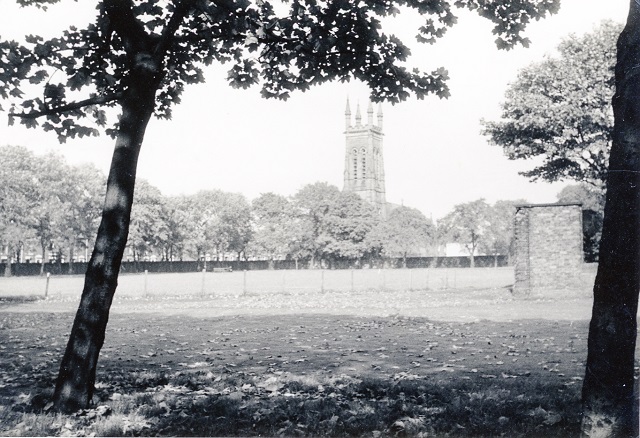
Part of the grounds of Griffin Lodge which the
children of Griffiin school were
occasionally allowed to use.
HEADTEACHERS OF THE GRIFFIN DAY SCHOOL
Boys’ Department Girls’ Department
Mr. Loynd Miss Lund
Mr. Bulcock Miss Coulthard
Mr. Woodcock Miss Scott
Mr. Gorse Miss Gorse
Miss Fulford (later Mrs. Knowles)
Miss Haworth
Miss Shuttleworth
Miss Noble
Mrs. Sagar
Mrs. Holden (Nee Shuttleworth)
The two departments joined and became
The Mixed School
Mr. Gorse
Mr. Thompson
Mr. Dixon
Mr. Wilkinson
Mr. Baldwin (Acting Head)
The Infants’ School
Mrs. Woodcock
Miss Pickering
Miss Gibbons
Miss Walsh (Acting Head)
Miss Eastwood (Mrs. Pearce)
Miss Wood (Mrs. West)
Mrs. Vause (Acting Head)
CORRESPONDENTS OF SCHOOL MANAGERS
Rev. G. A. Ashe Mr. A. Marsden
Rev. J. O. Pinck Rev. W. A. Swift
Mrs. A. Dugdale (40 years) Rev. J. Collier
Rev. W. E. Cunliffe Rev. L. J. Hakes
Rev. H. Broadbelt
HISTORICAL INFORMATION
Thomas Dugdale, Esq., of Griffin Lodge, Witton was the youngest son of Mr. Nathaniel Dugdale; he was born in 1797, and married Elizabeth, daughter of Mr. Thomas Walmsley, of Blackburn in 1824. He had three sons and three daughters. Thomas, Junior, was born in 1831 and married Ellen, daughter of Joshua Appleyard, Esq., he died in 1874. His second son Adam of Griffin Lodge inherited the estate on the death of his father on 17th March 1875. James Boardman Dugdale was the third son of Thomas Dugdale. The three daughters were Mary, wife of Mr. Miles Rodgett, of Wareham, Elizabeth, wife of Mr. R. B. Rodgett, of Walton-le-Dale; and Anne who married the Rev. W. T. Vale, Vicar of All Saints Church, Blackburn.
Thomas Dugdale, Esq., was Chairman of the Lancashire and Yorkshire Railway Co., of the Manchester and County Bank, and of the Blackburn Waterworks Company. He was Mayor of Blackburn in 1853-1854 and 54-55. It was during his mayoralty that the lodge and gates of Corporation Park were erected. He was first elected to serve on the Town Council in 1851. The first election held for Blackburn County Borough. He represented Park Ward. He was the third Mayor of Blackburn, the first mayor of course was Henry Hornby. It is interesting that the same builder who built our school, Richard Hacking, also built the Blackburn Town Hall.
Information recorded in 1877 Regarding the Township of Witton
Witton Township adjoins that of Blackburn on the west, and occupies the north and south slopes of Billinge Hill, which rises 807 feet above sea-level. The Darwen river is the boundary on the south. More than half the land of Witton was enclosed about 80 years ago, (1800), as a park to Witton House, the seat of the Feildens. The lower part on the south side, between the Darwen and the Blakewater rivers, has recently become a populous suburb of Blackburn, (1877) and has been embraced in the Parliamentary and Municipal Borough. The area of Witton is 650 statute acres. The population, since the invasion of the cotton manufacture has much increased. In 1801 it was 461, 1811 it was 819, 1821, 1067, 1831, 1047, 1841, 1073, 1851, 1367, 1861 showed a great increase 3293, 1871, 3803. Witton stocks was the situation of the old public town stocks, which were standing until about 1870.
Places of Worship in the Witton Area 1877
St. Mark’s Church
The church of Witton, dedicated to St. Mark stands on the hill side just outside of the eastern wall of Witton Park. It was erected at a cost of £700 including a gift of £200 and the site from Joseph Feilden, who laid the corner stone, October 6th 1836. The church was consecrated June 10th, 1837. The church contains 560 sittings. The Vicar of Blackburn was patron. The Rev. G. H. Ashe, B.A was Vicar from 1839. It was the Rev. Ashe who gave his support to the formation of the Parish of St. Philip and to the building of the Church in this Parish.
School Church, Griffin
On the Griffin estate the late Thomas Dugdale, Esq., built in 1870 a large school, which was also used for worship on the Sunday. Sittings 594. In 1877 it was recorded that a new church was projected.
See Mike Suners article "Witton Eyes Days Gone Bye"
Thanks to Mr. A. Gaffney for supplying the following sources:
'St Philip's Parish and Griffin C.E. School, Blackburn Centenary, 1871-1971', (Unknown Author).
The Parish of St. Philip Griffin - Blackburn'
See also St. Philips Church, Griffin
back to top
St. Silas's C of E School
By Barbara Riding
I attended St. Silas's C of E. School from the age of four in 1934, until 1941. I always looked back on the experience with nostalgia and affection, but it was not until 1985, they year of the school's Centenary, that I decided to do anything about it.
To celebrate the Centenary the children of the school gave a concert. It was made up of sketches, dances and songs showing the history of the school from 1885 until 1985. As I watched the entertainment I began to realise that much of the material that enabled the staff and scholars to tell the story must have come from the school's old log books. After the concert I asked John Duckworth, the headmaster of the school if I could look at the logbooks. He eventually lent them to me-four volumes, starting in 1881 and finishing about 1950.
The first entry in the first logbook is dated February 4th 1881, and I wondered what it was like in the area before the school was built.
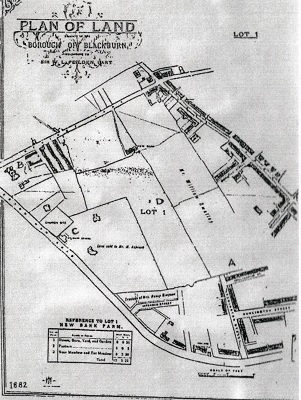
I was very fortunate to find a plan of the area in the Reference Library. It was published in 1882 by Sir William Fielden of Feniscowles Hall. The family was selling off its land and moving to Scarborough, and this plan referred to the New Bank estate. The plan shows some settlement at Mile End, Limefield, Revidge Lane Ends and Dukes Brow, bu the rest of the area is occupied by fields. One very interesting field (A) was where Blackburn Rovers played their home matches from 1881 until 1890, prior to moving to Ewood Park.
St. Silas's School was originally a Sunday School. Classes were held in the upper room of an old cottage in Dandy (now Dinkley) Square (B). When the building became overcrowded, the Vicar of Blackburn, the Revd J. W. Whittaker, applied to the National Society (National Society for Promoting the Education of the Poor in the Principles of the Established Church) for a grant towards the building of a school at Billinge End for "boys and girls of Long Row and the outlying farmsteads".
The school was subsequently built, and the inscription over the central window shows the date as 1834. As there was no St. Silas's Church in those days the building also served as a Chapel of Ease for St. Paul's. It is now St. Silas's Parish Centre. (C) For forty years it flourished as a Sunday School, but on February 4th, 1881 it re-emerged as a day school, with 24 girls and 41 boys. The Headmistress was Miss A. Moulding who was assisted by Miss Smith and two monitors. The hours worked and the holidays taken would not have gone down very well with the present generation. The sewing class lasted from 2pm until 4.30 pm, and when they broke up for the holidays in July, it was for 2 weeks, not 6. They did however get 2 extra days holiday in September 1882 to attend the Preston Guild.
The children were examined each January by one of Her Majesty's Inspectors of Schools. The result of this examination, as well as the attendance of the children at school, had a direct bearing on whether or not the school should receive the annual grant. At this time, the H.M.I.S was Mr W. H. Brewer, and in January 1882 he examined the children in Grammar and Geography.
In February the Curate-in-Charge Revd J. P. Petty brought in the Inspector's report: "This new school appears to be taught with care, and fair method...Grammar is only moderate. Geography is just fair. The Infant classroom should be fitted with a gallery or furnished with suitable desks."
I had no idea what a gallery was, but my mother-in-law, who attended the school in 1899, remembered. It was a set of benches starting at floor level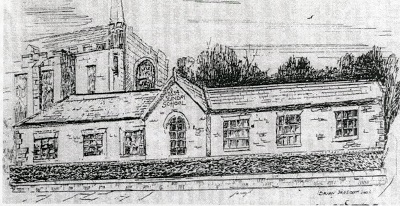 and rising up like the gallery in a theatre. She thought that the teachers lived at the top of the gallery. Well, she said, they were there when you went home from school, and they were still there when you returned to school the following morning, so she presumed that they slept ip there. One old lady, Edith Dewhurst, remembered sitting in the Gallery in 1892 when she was 3 years old. The teacher down below had a black lead brush in a jar of water on her desk. Every now and then she would walk up the gallery steps splashing the children's slates with the water. This was so that they could clean the slates properly without spitting on them!
and rising up like the gallery in a theatre. She thought that the teachers lived at the top of the gallery. Well, she said, they were there when you went home from school, and they were still there when you returned to school the following morning, so she presumed that they slept ip there. One old lady, Edith Dewhurst, remembered sitting in the Gallery in 1892 when she was 3 years old. The teacher down below had a black lead brush in a jar of water on her desk. Every now and then she would walk up the gallery steps splashing the children's slates with the water. This was so that they could clean the slates properly without spitting on them!
In 1883 Mr. W. H. Brewer inspected the school again. For their examination in repetition, the children recited:-
Standard I The Parrot and the crow
Standard II The Pet Lamb
Standard III lines from Casabianca
Standard IV-VI lines from The Ancient Mariner
The report was not very good.
"Arithmetic below fair. Other subjects only moderate. The Grant may incur a deduction next year under Article 115 unless the H.M.I.S can report more favourably. Monitor Annie Whiteside- failure. The issue of a certificate to Miss Moulding is deferred for a better report."
In 1884 there was some improvement, but the report said, "The teaching lacks vigour and reading is without intelligence and writing lacks uniformity of style. Annie Whiteside - failure. Miss Moulding will shortly receive her certificate". This however did not prevent Miss Moulding from receiving her notice, as her place as mistress was to be taken over by a master in the new school.
Due to a rapidly increasing population in the surrounding newly built streets, the little school on Preston New Road was becoming overcrowded. The School Board identified a need for a new school. A few worthy gentlemen got together and formed a Building Committee- Messrs W. H. Hornby, T. A. Aspden and C. Dixon. A site was secured between what is now St. Silas's Road and Clematis Street. The School Board was informed that a Church school would be built to accommodate 750 scholars. It was built with only one storey and a slim spire and was known as the School-Church. The building served also as a church until St. Silas's Church was built in 1898. A second storey was added to the school in 1904.
The new school was opened on August 10th 1885. Mr. Mark Russel was appointed headmaster. He had some scathing remarks about what had been going on before he took over and he wrote these down in the log book
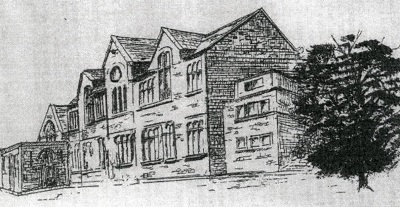
"Order has been very lax. The work in each class appears to have been carried out in a slipshod manner. Late coming is very prevalent. I have had to punish a number of children to maintain better order. They do not seem to understand that they must do a thing with being told once."
"October 14th. Standard III has improved a little under Miss Bish. I think the sooner Annie Whiteside retires from teaching the better for herself and everyone else."
"Standard II is a complete failure, there not being one redeeming feature in its favour. The only way to make any improvement at all is to get a master in the class in preference to a mistress."
From Mr. Russel we learn that the school day ended at 5 o' clock. On October 2nd 1891 he closed the school earlier than 5 pm owing to the weather having been so bad and the children not being able to play out. On another occasion he let them go at 4.30 pm during the Winter months as it was dark at night and some of the children had a long way to go.
In the days before education was compulsory, the teachers had a difficult time getting the children to go to school. Mr. Russel was frequently exasperated by it all.
October 9th 1885. "The attendance does not improve much, if any being specially faulty on Friday afternoons. I have only 23 children present against 42 this morning. It is quite the prevailing opinion that they can have 2 or 3 half days holiday a week and the Attendance Officer acknowledges himself powerless."
The weather played a large part in the non-attendance of the children.
January 5th 1887. "The attendance has decreased because of the snow. This is not new. A shower of rain at any time of the year and just before 9 or 2 o'clock caused the same decrease."
June 17 1888. "The attendance is very poor. Nearly the whole of the outside district children are absent, haymaking."
Many of the older children between 10 and 13 years old were half-timers, spending half a day at school and half a day at work. In September 1887, Mr Russel had a visit from Mr. Hamilton, the Factory Inspector, because John Riley, a boy working half-time at Garden Street Mill, had altered some of the figures in Mr. Russel's Time Book.
In 1892 an entry shows how the half-timers were employed:
36 worked in a cotton factory
2 worked in a workshop
3 were errand boys
10 were in domestic service at home!
In July 1891, Mr. Russel decided to give tickets to all children who attended school regularly. In the first week he gave out 128 tickets to all children who had been to school 10 times during the week. The children with the most tickets would receive a prize. A concert was held to raise money to pay for them.
In April 1892, 120 books were presented by Mrs. Henry Harrison to the successful scholars. Mrs. Harrison lived with her husband Alderman Henry Harrison J.P. across from the old school on Preston New Road in a house called Stanley. After her death in the 1930s, Stanley was demolished and Sacred Heart R.C. Church was built on the site. Hilda Stanford has a book "Next Door Neighbours" which was presented to her mother, Jennie Williams, for regular attendance at school in 1901. It is signed by Mark Russel
Inspection
In January 1886 Mr. Russel had his first Inspection. This is the programme of lessons which the teachers had to teach while being observed.
Miss Roylance The Ostrich. Joining new needle full of cotton.
Miss Bish First lesson on compound addition. Cutting out a chemise.
Miss Eastwood A darn. The noun.
Annie Whiteside Backstitching. The adjective.
Clara Kemp Needledrill. The Reindeer.
Mr. Russel's strictness and perseverance must have paid off. The report was good, the school only just falling short of receiving the highest merit grant.
Before the end of the first year the new school building had become overcrowded. It was decided to send the infants back to the old building and retain the new one for the Junior children.
February 4th 1886. "Gave a holiday for Friday so that the Gallery could be removed and taken and rebuilt in the old school on Preston New Road. This is to be reopened as a separate Infants Department on Monday morning with Miss Roylance as Mistress and Clara Kemp to assist her. Annie Whiteside left me as she has failed during the last 3 years to pass her examinations."
Corporal punishment has been phased out in schools now-a-days, but then, as in my day, most headmasters ruled with a cane:
Feb. 17th 1886. "I have caned a number of children for being late this morning."
Feb. 24th. "I gave William Henry Eddleston a stroke on the right hand and 3 on the back for disobeying Miss Dewhurst, and telling her that he did not care for her or anyone else."
Oct 24th. "I have had to speak very strongly to the children about throwing stones and swearing etc. at an encampment of gypsies above the school, and to cane 2 boys for interfering there after my warning."
Mr Russel however does not approve of other teachers using corporal punishment.
Feb 12th. "Complaints have been made against Miss Bish for using a stick to the children."
June 10th. "I have had to speak to all the teachers again about their using sticks and boxing ears."
The children received corporal punishment at the Police Station however.
Nov 13th 1888. "Three shawls were stolen from the cloakroom yesterday by a boy who lives in the neighbourhood. I called a policeman who captured the boy, who had sold the shawls and spent the money. He has been detained in custody and received 6 strokes with the birch as punishment."
Nov 17th 1890. "James Corless and Herbert Edmundson have been detained and sentenced to 6 strokes each with the birch for breaking into a neighbouring shop and stealing apples and cakes on Saturday night."
Interfering Parents
Teachers had complaints and notes from parents then, as I am sure they still do today:
June 1886. Robert Aspin sent a note saying that he wished his children not to be taught the Church Catechism as he did not believe part of it.
Aug 31st. Mr. Aspden, a farmer, the parent of 3 children, asked me to allow his boy, a half-timer in Std IV to leave school at 4pm every afternoon as he was required to assist with milking. This I was obliged to refuse, with the result that he has threatened to take all his children away and send them to Mellor or some other school where it can be allowed.
Mar 8th 1887. Some children named Barnes who left this school before Christmas have returned bringing a note from the mother saying that she could not get them to go anywhere else but here, and asking me to let them return, promising to pay the school money they owe.
Illnesses
There was a great deal of absenteeism through illness in those days. If one child caught measles or chicken pox or diphtheria, the whole family was excluded.
In December 1886 Mr Russel reported one of his teachers ill. Dec 7th Miss Bish is dangerously ill with pneumonia and a brain disease. There is not much hope of her recovery. Dec 13th - I am sorry to state that Miss Bish died today. Dec 15th I am absent from school this morning having to go into town respecting a flower wreath for which the children have subscribed to be placed on their late teacher's grave. Dec 16th In one of the local papers the death of Miss Bish is attributed to overwork. There is not the least foundation for such a report. She has never once complained of having too much work and up to falling ill she was most cheerful and to all appearances well.
Oct.1889 Scarlet fever has broken out in the district. One scholar Elsie Higson, died today.
Nov. 1889 The school has been washed out well and disinfected with sulphur.
Dec. 1889 All the diseases of mankind seem to have been let loose upon this school. Another scholar, James Edward Walsh, died on Saturday morning. The families at the following addresses are excluded:
It is interesting to note that the following addresses are so different from what they are today.
Long Row is now Manor Road Tean Barn Road is now Lynwood Road
Broom Street, Woodfold Place Double Street, West View Place
Rover Street, Wellfield Road Dandy Row, Mile End Row
Sarah Ellen Street, Devonport Road Banana Street, Brighton Terrace
School Dinners I always thought that it was a result of the Second World War that school dinners were started but there is evidence of them in 1891.
Jan. 22nd. Dinners were provided for 24 of the poorest children in school today, through the kindness of several people giving articles of food and the teachers preparing and cooking them.
Jan. 27th. Dinners were provided for the poor children by the kindness of Mrs. Henry Harrison and others.
Holidays were given during the year usually for Royal Events:
June 1887 The school was closed for a week to celebrate Queen Victoria's Golden Jubilee.
May 1888 A holiday was given on the occasion of the Royal Visit by the Prince and Princess of Wales, to lay the foundation stone of the new Technical School.
July 5th 1893 Gave a holiday for tomorrow in commemoration of the Royal Marriage of the Duke of York and Princess Mary of Teck. Also gave notice that the school will not open until 9.30 am on Friday as no doubt many children will be up late on Thursday night seeing the fireworks in the Park.
May 24th 1900 Ascension Day and the Queen's birthday. Gave a holiday. The scholars attended church and returned to school where they all received an orange. After singing "Soldiers of the Queen" and "God save the Queen" with 3 cheers for the Queen and Lord Baden Powell, the children went home to celebrate the relief of Mafeking after its 'gallant siege of 216 days'.
Jan 28th 1901 Following Queen Victoria's death King Edward VII was publicly proclaimed by the Mayor. The school closed for the remainder of the day to allow scholars the opportunity of going into town and witnessing the event.
The end of the Victorian Era was also the end of Mr. Russel. He finished as headmaster at the end of the year, and the school entered the Edwardian Period, or in other words, the reign of Mr. Clough.
There were changes to the map as well. Streets of houses had grown where there were once fields. Blackburn Rovers Football team had gone to Ewood Park, and Leamington Road Baptist Church had been built on the site (1895).
Early 1900s
Children inevitably found more interesting things to do than attending school, as we learn from the entry of July 10th 1903. The following boys disappeared from the school at playtime this afternoon.
James and Richard Blackburn 21 Double Street
Thomas Williams 143 Dukes Brow
Fred Thomas 120 Dukes Brow
"Investigation elicited the information that they had gone to the golf links to caddy. Their attendances were cancelled and a list of names sent to the Attendance Officer."
Nov 1904 The following boys are late for school every morning due to milk kitting. William Clark and Frank Merrin engaged by James Coar, Meins Road and George Dewhurst employed by Thomas Haydock, who did not liberate him until 9.50am.
There is an occasional reference to the type of lessons that the children had in those days.
May 1905 Mr. Clough took a party of 20 children to Billinge Wood to teach them to recognise trees and plants.
Jan 1906 Miss Knowles gave a criticism lesson on "the moods of verbs".
May 1906 The children had a lecture on "Alcohol and its effects" by Mr. de Vit, a C of E Temperance Society lecturer. The children had to write essays afterwards, and the best received a silver medal.
Accidents
The accidents which took place in the school were not very serious, mostly trapped fingers and banged heads, but they had to be recorded in the log book.
Jan 1836 Phoebe Dodd, Std I, caught her eyelid on a small dress hook on a cloak in the cloakroom when marching into school. Mr. Russel succeeded in getting it loose and after bathing the eye in cold water it was no worse from the accident.
Oct 24th J. Whalley fell off a form in the classroom, and striking his head against the firegate he made a fearful gash in it. This incident was a pure accident. The boy blames it on his clogs.
In November 1907 there was a dramatic account of an accident concerning a game of diabolo. "This afternoon immediately before the bell rang for Assembly, Freddie Short in Std I received a nasty cut on the right temple which necessitated medical attention. The scholars were arranged in a ring watching the boy play diabolo. He had thrown his diabolo to a rather great height, somewhat obliquely, and was rushing sideways to catch it in its descent when the bell rang. The rush of the boys caused little Short to be knocked on the floor, and he appears to have been kicked by a boy's clog. The doctor put 3 stitches in the wound. This morning he is reportedly to be progressing satisfactorily."
Teachers were not immune from accidents. In May 1921 we learn that Miss Middleton was off duty due to a broken fibula while learning to ride a bicycle. On another occasion Miss Middleton was absent, having broken her teeth.
1914-1918 War
The First World War did not make as much impression on the school as the Second World War was to. In November 1914 Mr. Clough received a sovereign from St. Silas's Conservative Club to provide wool for the children to knit scarves and mittens for the troops at the front.
Mon 11th Nov, 1918 The school was closed to celebrate the signing of the Armistice. Sept 5th 1919 The Peace celebrations took place. The school closed at noon and a children's party was held. After tea there was a concert and on the Saturday children's sports were held at the Rover's Football Ground at Ewood Park.
1914-1918 War
The First World War did not make as much impression on the school as the Second World War was to. In November 1914 Mr. Clough received a sovereign from St. Silas's Conservative Club to provide wool for the children to knit scarves and mittens for the troops at the front.
Mon 11th Nov, 1918 The school was closed to celebrate the signing of the Armistice. Sept 5th 1919 The Peace celebrations took place. The school closed at noon and a children's party was held. After tea there was a concert and on the Saturday children's sports were held at the Rover's Football Ground at Ewood Park.
More Holidays
June 2nd 1902 The school assembled as usual but was dismissed at 10 o'clock after singing the National Anthem. The event was the signing of the terms of peace in the Boer War.
June 22nd and 23rd 1911 Two days holiday for the Coronation of King George V and Queen Mary.
The children always had a holiday on Shrove Tuesday but the Education Committee was very wise when it cancelled the Shrove Tuesday holiday in 1925. Blackburn Rovers were playing Tottenham Hotspurs in a cup tie match the following Thursday. Anticipating that some of the children might be staying off school to watch the match, they gave them the Thursday holiday instead.
The last holiday under Mr. Clough's headship was in June 1928, when all the schools in Blackburn had a holiday to commemorate the Opening of the War Memorial Wing of the Royal Infirmary. Mr. Clough retired in the August, his place as headmaster being taken by Mr. Ambrose Merrill.
Mr. Merrill
Mr. Merrill was coming home to roost as it were. He'd been a scholar at St. Silas's School and then a Pupil Teacher. He'd taken various exams and gone on various courses to qualify for his certificate. For the previous five years he had been the headmaster of St. Paul's School Oswaldtwistle.
So now the third part of the story brings the school up to its 65th birthday in 1950. The greatest difference between the three eras is the amount of space in the log book given to illnesses. A teacher and two pupils died in Mr. Russel's time. Whole families were excluded if one child was ill. In Mr. Merrill's time the only reference to illness comes in January 1930 when the Medical Officer authorised three boys to be excluded, 2 for ringworm and 1 for scarlet fever
Christmas
I remember very well the Christmas parties we used to have at St. Silas's School. We had to go in fancy dress, play games, sing Community Songs (My Darling Clementine, Polly wolly doodle all the day) and be entertained by Mr. Brown performing conjuring tricks. Mr. Merrill reminded me of them in the log book.
December 1934 The 7th annual Christmas party. The mothers provided refreshments. Under the supervision of Mrs. Merrill four senior girls set the tables. Mr. Brown entertained with conjuring tricks, followed by games conducted by the headmaster. All the teachers, with the exception of Miss Middleton, loyally assisted in this effort, which finished at 7pm with "Auld Lang Syne".
December 1935 The 8th annual Christmas party. The arrangements were as in previous years. All the teachers assisted, with the exception of Miss Middleton.
December 1936 The 9th annual Christmas party. Mr. Brown entertaind with conjuring tricks. All the teachers, with the exception of Miss Middleton, supported me in conducting the games programme.
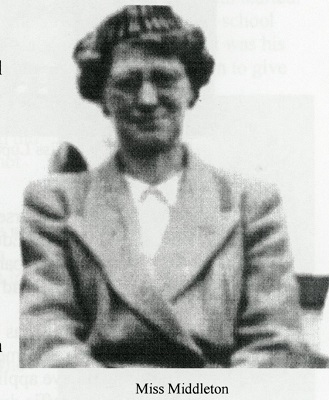
Mr. Merrill had quite a bit of trouble with Miss Middleton as we all had. We were terrified of her, but with hindsight realised what a good teacher she was. In July 1937, Mr. Merrill wrote that the exceptional number of scholarships that year was undoubtedly due to the efficient teaching in English to Standard V by Miss Middleton.
Russell Harty put Miss Middleton on the map when he wrote an article about her in the Daily Express in 1982, "A Voyage around my Teacher" told how he was in awe of 'Miggy' which was her nickname. He remembered her unorthodox methods of teaching (by today's standards), the hymns and songs she taught, the way she played the piano, her Morris convertible car. Her teaching of grammar, her love of English, her handwriting all had an influence on his education and future career.
Special Events
The children of St. Silas's School, as those in all other schools were encouraged to grow bulbs each year for an exhibition. In 1930 Mr. Merrill records "111 children conveyed by tram to King George's Hall carrying pots of bulbs they had grown for the Bulb Exhibition."
In 1934 Mr. Merrill and Mr. Brown took a party of 48 children to London. It was the Blackburn and Darwen children's trip, and two trains conveyed 1200 children at a cost of 13 shillings each. This included train fare 8/6d, bus fare 1/1d and two meals at a shilling each.
In 1937 the country celebrated the Coronation of King George VI and Queen Elizabeth. Before being given a holiday the school held a fancy dress party. I remember feeling very patriotic because I went in a red, white and blue sailor suit which I had worn for a dancing display. Mr. Merrill records that the Local Authority provided cakes, tarts, chocolate, ice-cream, oranges and coffee, and each child received a souvenir mug or cup and saucer and plate.
In December 1937 the scholars gave a Grand Concert to raise money for repairs to the school yard. There was a copy of one of the programmes in the log book. Each class provided a different item, a play, a puppet show, a physical training display, a musical item. Standard 1 opened the concert with "A Visit from Fairyland" performed by Barbara Brett (the author)! I was going to a dancing class in those days so fortunately I had a ballet dress. With a wand and a pair of wings I was soon transformed into a fairy!
Many children had their first taste of Shakespeare at St. Silas's School. On the rare occasions when Miss Middleton was away Mr. Merrill took the class and we read and acted "MacBeth" and read, acted and learnt songs from "As you like it".
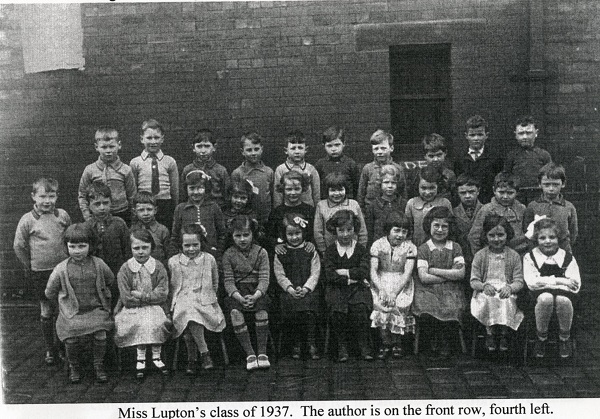
World War II
The Second World War of course upset the smooth running of the school. As early as September 1938, Mr. Hall, the Director of Education, visited the school to discuss emergency plans. It was decided to move the Infant Department to the Parish Rooms on Preston New Road and the Junior Department to Leamington Road Baptist Sunday School.
August 1939 "This building has been requisitioned as a First Aid Post. The school was closed this morning and the children informed that they must attend Leamington Road Baptist Sunday School on Monday morning. I have applied to the Chief Constable that the lower half of Lynwood Road, a cul-de-sac, be closed to traffic during school hours as I should like it for a girls' playground. The boys are to use the passages at the back of the school as their playground".
Behind Lynwood Road there is a patch of spare land known as Fox Delph. In 1940 an underground air-raid shelter was built there for the children of the school. August 19th, "I received the key of the air raid shelter built on the delph at the end of Cheltenham Street". August 20th, "The first air raid practice-Time taken for all the children to pass through the shelter and back to school, 14 minutes." August 21st, "Second practice with coats and gasmasks was 11 minutes". January 10th, "The first lesson was given in the air raid shelter following an 'alert'."
The winter of 1940 was particularly severe, there was no outdoor P.T. Snowdrifts prevented the children from getting to school. School was closed when there were only 83 children present. School was closed again when there was no coke to heat the building.
During the war there was a large thermometer painted outside the Town Hall. As you rode past on the tram you could see the red line on the thermometer rising higher and higher as the money rolled in. The school children in Blackburn contributed to that money.
February 1942, A holiday given for Warships Week. The school collected £63.
April 1943, Total collected for Wings for Victory Week was £320.
April 1944, The school collected £449 for Salute the Soldier Week.
In April 1943 the Junior School returned to the building on Clematis Street, after an absence of 3 1/2 years. Mr. Merrill wrote that the conditions at Leamington Road had been far from ideal. The rooms were not large enough, and the toilets inadequate. There were leaded lights in the windows and the children had to dodge cars and washing in the playground. But the Committee at Leamington Road had been very considerate, and the caretaker Mr. Robbins had given loyal service.
Aftermath
However, conditions were not back to normal. There were still blackout shields at the windows, and linen instead of glass in the partitions between the classrooms. The boys cloakroom was still being used by A.R.P. personnel. The air raid shelters in the playground were in a filthy condition. There was no staffroom and the head teacher's desk was in the corridor.
In November Mr. Merrill was off ill. On his return he wrote, "I resumed duty after an absence of 10 weeks due to personal illness. As this breakdown in health has been due to the school conditions during the last 5 years, it is interesting to note that the only improvement during those 10 weeks has been the removal of the blackout shields."
In March 1945 things started to improve. The plumber dismantled some washing apparatus in an upstairs classroom. Now Mr. Merrill would have a head teacher's room and be able to move his desk from the corridor. In July 1946 the WCs were whitewashed, for the first time since the war started. But it was February 1947 before workmen started to demolish the air-raid shelters in the school playground. May 18th 1950 was Ascension Day and a special day for Mr. Merrill. It was his last official visit to the church with the children and the vicar kindly gave him permission to give the address. This revived my memories of going to St. Silas's Church on Ascension Day morning after which we had a holiday. But the girls had to wear a hat! If you had forgotten yours, and did not live near enough to be sent home for it, you had to tie a know in four corners of your handkerchief and wear that!
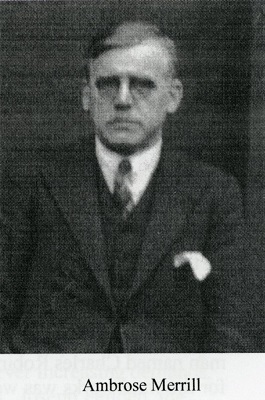
August 31st 1950 This day, I, Ambrose E. N. Merrill complete my services as headmaster of this school. I entered the school as a scholar, was a pupil teacher and a teacher here, served 3 years in the First World War and 5 years as headmaster of St. Paul's, Oswaldtwistle.
I here record my appreciation of the services of the teachers who have been my colleagues. Miss Middleton-32 years, Mrs Nicol-22 years, Miss Shuttleworth-14 years, Mr McLellan, my successor-3 years and Mr Hallows-1 1/2 years. I thank them for their help, especially during the last few years, and making it possible for me to commence my retirement, a very contented man.
And so, as Charles Lamb wrote, "Gone, all gone are the old familiar faces". Gone, yes, maybe, but never, never forgotten.
Sources used-
St. Silas School Log Books
Blackburn Reference Library
Transcribed from Blackburn Local History Journal by Shazia Kasim
February 2024

